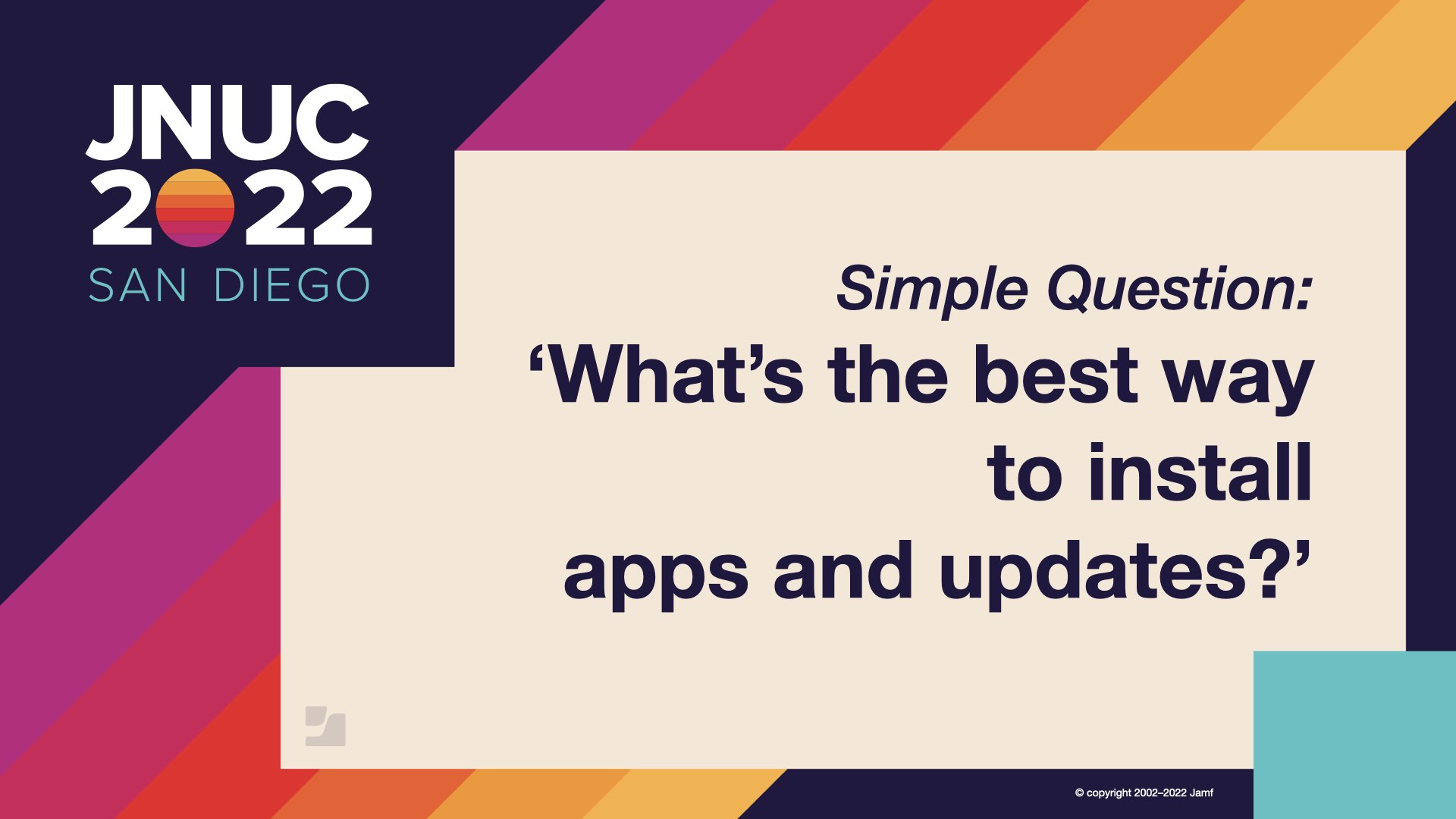
App and deployment considerations
The first stage of your app lifecycle management process requires consideration about each app’s requirements and deployment options. Smith lists these as important app considerations:
- Is this a critical app?
- Is this a core app?
- Is this a system app?
- Does this app have a complex install or require configuration?
- Is this app offered through multiple channels?
He expands on these deployment considerations:
- How flexible are my options?
- Can it facilitate testing?
- Is it scaleable?
- Is it easy to use?
- Is it low maintenance?
- How easy is it to troubleshoot?
Installation options
Jamf Pro offers multiple options for app deployment and patch management. Which option is best for your application depends on your answers to the considerations above. Smith walks us through each option’s use cases, advantages and disadvantages. To summarize:
- Third-party app installers are a simple solution for core and system apps offered through multiple channels, but have limited flexibility and testing options.
- Apple’s App Store is useful when the app is not available in third-party app installers and provides more flexibility in updating apps. It is not ideal for company-critical apps since you have little control over the apps.
- Jamf App Installers, part of the Jamf App Catalog, is a curated collection of Jamf-managed and Jamf-provided installer packages that automate and streamline updating and deploying third-party apps.
- Configuration profiles are good for non-critical software updates. They are low maintenance but require knowing the specific requirements for each application.
- Jamf product integrations like Jamf Connect and Jamf Protect are helpful for core and system apps or apps that have a complex installation or configuration. It offers flexibility and testing, but is not scalable beyond the integrations.
- Patch management does a good job of keeping already installed apps to date, and uses polices to install packages. It is good for critical, core and system apps, and is flexible, scalable, and suitable for testing. This method cannot install new apps and requires more upkeep from the admin.
- PreStage enrollment is useful for critical, system and complex apps, but should be used sparingly to keep the enrollment process as simple as possible.
- Policies can be complex to set up and configure, but offer the most robust options. You can use scripts, smart groups and have multiple policies. Since they are complex, if an app is available in the App Store or app installer, those options should be considered first.
Another alternative that doesn’t rely on Jamf Pro is to install an app manually. Generally, this should only be used for one-offs, that is, when the effort to configure Jamf Pro to install the app outweighs the effort to install it manually. If the app requires frequent updates or needs to be installed on many devices, the above options can be revisited.
Examples
Smith provides examples of how to handle different app installations. He starts with Microsoft Office apps. If your company considers these core apps offered through multiple channels, you can choose to deploy them by using a policy while managing updates with a profile. You are even able to do any testing by creating separate testing and production profiles and scoping them to the correct groups.
Another example is Slack. Your company may not consider this a core, critical, system or complex app, but it is offered through multiple channels. In this scenario he opts for using the App Store over app installers, though both would work, as the App Store gives the option for automatic updates.
Smith also walks us through how he can handle SAP Privileges, Jamf Connect and a hypothetical app with a complex installation.
Subscribe to the Jamf Blog
Have market trends, Apple updates and Jamf news delivered directly to your inbox.
To learn more about how we collect, use, disclose, transfer, and store your information, please visit our Privacy Policy.
